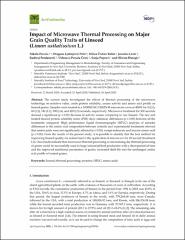Impact of Microwave Thermal Processing on Major Grain Quality Traits of Linseed (Linum usitatissium L.)

View/
Date
2020Author
Puvača, Nikola
Ljubojević Pelić, Dragana
Živkov-Baloš, Milica
Lević, Jovanka
Prodanović, Radivoj
Puvača Čović, Vidosava
Popović, Sanja
Đuragić, Olivera
Metadata
Show full item recordAbstract
The current study investigated the effects of thermal processing of the microwave
technology on nutritive value, crude protein solubility, urease activity and amino acid profile on
linseed grains. Samples were treated in a SAMSUNG GE82N-B microwave oven at 450W for 0 (L1),
60 (L2), 180 (L3), 300 (L4), and 420 (L5) seconds, respectively. Microwave treatment for 300 seconds
showed a significant (p ≤ 0.05) decrease in activity urease comparing to raw linseed. The raw and
treated linseed protein solubility index (PDI) show statistical differences (p ≤ 0.05) between all the
treatments compared. High performance liquid chromatography (HPLC) analyses of samples
differences in the amino acid composition between controls and experimental treatments showed
that amino acids were not significantly affected (p ≥ 0.05), except isoleucine and leucine amino acid
(p ≤ 0.05). From the results of the present study, it is possible to identify that the best method for
improving linseed quality for animal feed is the application of microwave for 60 second (treatment
L2). Our results indicate that microwave thermal processing or micronizing dry thermal processing
of grains could be successfully used in large industrial feed production with a short period of time
and the improved nutritional parameters of grains, increased shelf-life and the unchanged amino
acid profile of treated grains.
